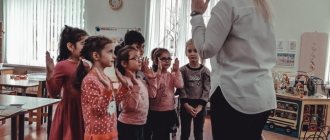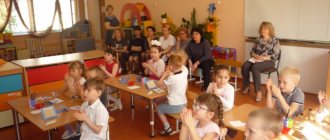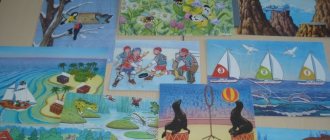Logostales in the correctional work of a speech therapist
Logo tales in the correctional work of a speech therapist
Author: Radulova Svetlana Mikhailovna, teacher-speech therapist, Municipal Educational Institution “Bendery Kindergarten No. 9”, Bendery. Description of the material: I offer a report from the experience of a speech therapist teacher on the use of innovative technology - logostories in correctional work with children with speech disorders. The material will be useful to teachers and speech therapists of preschool institutions.
When working with children with speech disorders, a fairy tale is an effective developmental and correctional tool for the development of all aspects of speech. E.N. Vinarskaya notes that emotional discomfort negatively affects the development of all aspects of speech. Therefore, the speech therapist and teacher in joint activities need to ensure a positive attitude and maintain interest in the exercises being performed, consolidate and improve it in a new situation. A fairy tale is a good helper in this work. Methodological work with fairy tales has a long history. The term “fairy tale” first appears in the seventeenth century. The fairy tale was “mere fun”, worthy of the lower strata of society. Later, based on the research of B. Bettelheim, R. Gardner, C. Jung, V. Propp, a modern concept of working on a fairy tale was built. At the present stage, the method of working with fairy tales is being actively developed by many famous teachers and psychologists (T.D. Zinkevich-Evstigneeva, T.M. Grabenko, V.A. Gnezdilov, G.A. Bystrova, E.A. Sizova, T.A. Shuiskaya, M.A. Povalyaeva, etc.). The Institute of Fairy Tale Therapy, which was opened in St. Petersburg, is developing a methodology for complex work with fairy tales for children who have developmental disabilities. K.I. Chukovsky noted that adults think in words, verbal formulas, and small children - in things, objects. According to D. Rodari, “Fairy tales can help educate the mind, give keys to enter reality in new ways, can help a child get to know the world and gift his imagination.” Speech therapy fairy tales are those fairy tales that provide significant assistance in working with children experiencing difficulties in speech development. Logostales
are a holistic pedagogical process that promotes the development of all aspects of speech, the education of moral qualities, as well as the activation of mental processes (attention, memory, thinking, imagination).
Logo-fairy tales can be used by speech therapists and educators in their work with children with speech disorders. Fairy tales are taught as a whole lesson, didactic game, theatrical performance. A speech therapy fairy tale requires the active participation of children in the course of the story. The goal of a logos fairy tale is the comprehensive, consistent development of children’s speech and related mental processes through the use of elements of fairy tale therapy. Speech therapy fairy tales are simple in content, small in volume so that the child can understand their content and retell it. All work using logo tales is based on general didactic principles
: - systematicity and consistency, - taking into account age characteristics, - taking into account individual characteristics, - taking into account the structure of the defect, - stage-by-stage speech correction.
It is necessary to take into account the child's interest, joy, imagination, improvisation, emotional attention and memory. Using logo-fairy tales, its storylines can solve correctional problems
: – create a favorable environment for the child’s speech activity and creativity in order to increase the effectiveness of the play motivation of children’s speech;
- develop all aspects of the speech functional system in a form that is entertaining for preschoolers; – develop the psychological basis of speech, the relationship between the visual, auditory and motor analyzers; – to carry out the cooperation of the teacher-speech therapist with children and with each other on the basis of a personality-oriented model of interaction between participants in the educational process, to create an atmosphere of mutual understanding and mutual assistance. There are the following types of logostories
: 1. Articulatory (develop speech breathing, articulatory motor skills) 2. Finger (develop fine motor skills, graphic skills).
3. Phonetic (clarify the articulation of a given sound, automate, differentiate sounds). 4. Lexico-grammatical (enrich vocabulary, consolidate knowledge of grammatical categories). 5. Fairy tales that promote the formation of coherent speech. 6. Fairy tales for teaching literacy (introduce sounds and letters). Also distinguished: 1. Logostales of a didactic plan with the inclusion of various exercises, tests, performing tests, etc. (T. D. Zinkevich-Evstigneeva): - Articulatory. - Phonetic. — Fairy tales for teaching literacy. 2. Logo tales aimed at developing the polysensory ability of a child with speech impairment (“fairy tale” plus “objective activity”) (O. G. Ivanovskaya, E. A. Petrova, S. F. Savchenko): - Finger. 3. Logo-fairy tales-trainings, rich in certain phonemes, word forms, lexico-grammatical categories (author’s tales of speech therapist teachers G. A. Bystrov, E. A. Sizova, T. A. Shuiskaya) - Lexico-grammatical. 4. Logostales with modeled content (T. A. Tkachenko). — Fairy tales that promote the formation of coherent speech. Fairy tales are staged by different types of theaters
: - Finger Theater. Dolls, sewn or knitted, cut out of paper, are placed on the finger.
- Theater bi-ba-bo. The puppets are placed on three fingers of the hand and act on a screen or at a table.
- Shadow theater. Planar images of dolls or images of shadows using hands are shown on a lighted screen.
— Table theater. Cone theater puppets and plane figures act on the table.
- Theater of mittens. Children's mittens and gloves are put on the hand. -Toy Theater. The scenes are played out and shown to children with ordinary toys: soft, rubber, kinder surprises.
-Theater on flannelgraph. Planar images move on the flannelgraph.
Finger tales Finger tales: - stimulate the action of the speech zones of the cerebral cortex, which has a positive effect on correcting children’s speech; — improve mental processes: attention and memory, which are closely related to speech; — increase children’s interest in Russian folk tales and the small folklore genre. Teachers use finger gymnastics, individual games and exercises every day in class to develop fine movements of the fingers, which are accompanied by poetic texts. Such exercises are very emotional and simple. In order to interest children and avoid monotony in performing such exercises, finger games are combined into short fairy tales and stories on the same or different topics. The Tale of a Little Kitten
One day a little kitten went out into the yard
(The middle and ring fingers rest against the thumb. The index finger and little finger are raised up)
.
The sun was shining brightly in the sky (Palms crossed, fingers spread wide, forming “sun and rays”)
.
A rooster sat on the fence and crowed loudly (Palm up, index finger resting on thumb, remaining fingers spread out to the sides)
.
A hen and her chicks were walking around the yard (Palm up, index finger resting on thumb, rest of fingers bent)
.
Suddenly the kitten saw a large dog (The right palm is placed on the edge, towards itself. The thumb rises up. The index, middle and ring fingers are together. The little finger alternately lowers and rises
).
She began to growl loudly (pronounce: rrrr)
and the kitten ran away.
A duck with ducklings swam in the pond (Make smooth movements with the hands of both hands from right to left, then imitate the movements of the duck’s legs in the water
).
A goose walked importantly nearby (Place your hand with your elbow on the table, all fingers straight. Move four fingers, except the thumb, forward and press tightly together (“the goose’s head”). Lower your thumb a little down. It turns out to be a “goose” with an open “ beak")
.
A little goat was walking in a clearing (The index finger and little finger are put forward and move in different directions. The middle and ring fingers are pressed to the palm and clasped with the thumb)
.
He had small horns (the baby goat “butts”
), but the kitten was not afraid.
Suddenly, clouds appeared in the sky and rain started dripping: drip-drip-drip (Press the pads of your right and left hands to the table. Alternately tap them on the surface of the table, like playing the piano)
.
The kitten quickly ran home (Create a “roof” angle with the fingers of both hands, connecting them with pads at an angle. Connect your thumbs in a straight line)
.
Articulation fairy tales Complexes of articulation exercises are combined in the form of fascinating fairy tales about the Tongue. Such tales arouse children's interest in the organs of articulation, develop their mobility, and activate visual perception. All exercises in the fairy tale about the Tongue are performed in front of a mirror. The game character who creates a favorable emotional background in individual lessons is the frog Quackie. An adult puts the doll on his hand and asks him to perform articulation exercises. The child's interest increases while working independently with this wonderful toy.
In the “Theater of Fingers and Tongue,” the movements of the tongue are accompanied by synchronized movements of the hands, which act as assistants. Tale about a kitten (for hissing sounds)
The girl Masha had a fluffy kitten (
The middle and ring fingers rest on the thumb. The index finger and little finger are raised up)
.
Every morning Masha kneaded the dough (Open your mouth a little, calmly put your tongue on your lower lip and, smacking it with your lips, pronounce the sounds “five-five-five...” Hold your wide tongue in a calm position with your mouth open, counting from one to five to ten . Clench your fingers into a fist and spread them apart)
and bake pancakes (
Smile, open your mouth slightly, put the wide front edge of your tongue on your lower lip. Hold it in this position for a count of one to five to ten. Place the palms of both hands on the table and turn them over back side)
.
The kitten really loved pancakes with sour cream (Open your mouth slightly and lick your upper lip with the wide front edge of your tongue, moving your tongue from top to bottom, but not from side to side. Fold your palms into a “bucket”)
.
And Masha greased each pancake with jam (Open your mouth slightly and lick your upper lip with the wide front edge of your tongue, moving your tongue from top to bottom)
.
Masha poured tea into beautiful deep cups ( Mouth open. Lips in a smile. Stick the tongue out of the mouth. Raise the side edges and tip of the tongue, lower the middle part of the back of the tongue, bend down. Cup your palms)
.
The tea was hot, so the kitten blew on it and cooled it (Smile, open your mouth slightly, put the wide front edge of your tongue on your upper lip so that the side edges are pressed, and there is a groove in the middle of the tongue, and blow off the cotton wool placed on the tip of your nose. Air in this case, it should go in the middle of the tongue, then the fleece will fly up)
.
After breakfast, the kitten went outside for a walk. Phonetic tales Phonetic tales involve working on a disturbed sound or group of sounds. They select speech material based on automated sounds or differentiated sounds. In children with complex speech disorders, persistence of sound pronunciation defects is observed. To obtain sustainable results in working with such children, multiple repetitions of words and phrases for certain groups of sounds are required. Once in a logo-fairy tale, the child travels through it together with the main characters, helps in difficult situations, worries with them, supports them, and makes decisions. As a result, there is an unobtrusive consolidation of difficult sounds (automation of isolated sound, sound in forward and backward syllables, words, phrases, sentences, pure phrasing, poetry and in phrasal speech). Tales for teaching literacy Logostales: - introduce children to vowel and consonant sounds, - form the concepts: “sound”, “letter”, “vowel sound”, “consonant sound”; - develop auditory attention; - develop phonemic hearing; - introduce children to vowels and consonants, reinforce visual images of letters; - form and differentiate the concepts “sound - letter”. The main characters of fairy tales are sounds and letters, endowed with their own characters. During classes, children are immersed in the world of fairy-tale characters from the Kingdom of Sounds and Letters. Six glasiks (vowel sounds) live in the red palace. In the blue and green palace live consonants (consonant sounds).
Summary of a logo-tale lesson on teaching literacy “Sounds [v], [v']. Letter B" /blogs/svetlana-mihailovna-radulova/konspekt-zanjatija-po-obucheniyu-gramote-v-starshei-logopedicheskoi-grupe.html Lexico-grammatical tales Lexico-grammatical tales (G. A. Bystrova, E. A. Sizova, T. A. Shuiskaya) carry a certain lexical or grammatical load. Logo tales use various methods of enrichment, activation of vocabulary, word formation, and inflection. Fairy tales that promote the formation of coherent speech Types of work with fairy tales: 1. The child acts out familiar fairy tales. 2. Several children, having previously distributed the roles, act out a fairy tale. 3. The child acts out a fairy tale based on what he saw, but changes the characters, time, and end of the action. 4. The child acts out and models a fairy tale based on a set of toys offered or chosen independently. At the same time, the child independently demonstrates the fairy tale and comes up with its plot. Thus, the most complex form of coherent utterance develops - composing creative stories. 5. Preparation and presentation of musical and speech therapy tales.
Dramatizations of fairy tales activate the movements of the organs of the articulatory apparatus, form the lexical and grammatical structure of speech, develop general and fine motor skills of the fingers, coordination of movements, facial expressions, pantomime, mental processes (imagination, emotional-volitional sphere, attention, perception), creative abilities. Children develop melodic-intonation expressiveness, develop coherent monologue speech, and automate sounds in the text. The use of logostories in correctional work allows the speech therapist to establish emotional contact with the child, create a joyful mood in him, activate verbal communication, provide an unobtrusive educational impact, replenish the stock of knowledge and information, improve mental processes (attention, perception, imagination, memory, thinking), develop all aspects of speech. Literature:
1. Arkhipova E.F. Speech therapy work with young children. – M.: ACT. Astrel, 2006. 2. Zinkevich-Evstigneeva, T. D. Workshop on fairy tale therapy / T. D. Zinkevich-Evstigneeva. – St. Petersburg: RECH, 2001. 3. Ivanovskaya, O. G. Speech therapy tales for speech development: Fairy tales in nature-conforming education / O. G. Ivanovskaya, E. A. Petrova, S. F. Savchenko. – St. Petersburg: KARO, 2008.
We recommend watching:
Methodological development for fairy tale therapy Development of dialogic speech in compensatory groups Advice from a speech therapist teacher for parents Formation of the syllabic structure of words in children with special needs development
Similar articles:
Speech development in children 3-4 years old with developmental disabilities based on Suteev’s fairy tales
Booklet on the fairy tale
The benefits of fairy tales.
1
)
Fairy tales develop attention.
Listening to the description of events, miracles occurring and the adventures of the characters, the child uses all his attention and maintains it throughout the entire story.
2) Instill the concepts of good and evil.
In fairy tales, all characters are divided into good and bad, kind and evil. Listening to fairy tales, the child understands what is good and what is bad, how to do the right thing and what not to do. In addition, children tend to imitate their favorite heroes.
3) They introduce you to the world around you and people’s relationships.
4)They learn to cope with difficult situations.
5) Fairy tales console.
6)Fairy tales develop children's speech and imagination.
Reading fairy tales expands a child's vocabulary and helps develop speech. Listening to a fairy tale, the child gets acquainted with folklore, remembers proverbs and sayings (“Don’t sit in the wrong sleigh”, “There is no better friend than your own mother”). It is no coincidence that teachers and speech therapists use fairy tale therapy for classes with children with speech delays. Fairy-tale images help develop children's imagination. Putting himself in the place of a positive hero, a child can engage in battle with an enemy (a thicket of nettles) using a magic sword (stick) or go to Mars in a rocket made of pushed together chairs. Psychologists say that fantasy helps a child develop intelligence, so imagining for a child is very useful.
7) The benefits of fairy tales before bed.
From time immemorial, fairy tales have been used as a means of positively influencing the emotional state of a child. The most striking example of this impact is a bedtime story. The child listens to the soothing, lulling rhythm of the words, hears his native voice - everything is fine, his mother is nearby, a fairy tale story takes him further and further from the day's sorrows and joys, and finally he falls asleep. By the way, if your child is bothered by bad dreams, then a fairy tale will easily help you cope with this problem.
2. Rules for working with fairy tales.
A fairy tale must be selected depending on the child’s age and possible developmental characteristics. Start with the classics of children's literature: K. Chukovsky, S. Marshak, A. Barto, S. Mikhalkov, D. Kharms, Y. Moritz, V. Suteev, I. Tokmakova, V. Levin, K. Ushinsky, B. Potter, G. Boyko. Children of this age love folk tales about animals (“Turnip”, “Teremok”, “Goat-Dereza”, “Wolf and Seven Little Goats” and others), as well as folk nursery rhymes, counting rhymes and jokes. If your child does not show interest in listening, and subsequently in reading fairy tales? Don’t be upset, because you can invite him to play with a fairy tale and do everything at home, with his own hands. Do-it-yourself mini-theater at home, together with your child, who will gradually develop an interest in what you are doing together.


